
views
Planting Cauliflower
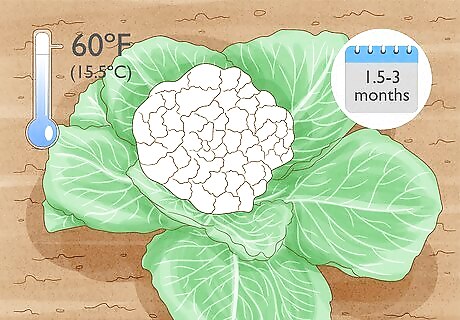
Plan to grow cauliflower in cool weather. Most cauliflower varieties require about 1.5-3 months of consistently cool weather to mature properly. Ideally, the daytime temperature while the cauliflower is maturing will be around 60ºF (15.5ºC). This means that the proper planting time depends on your climate: Cool climates: If your late summer temperatures are below 80ºF (27ºC), you can plant cauliflower for a fall harvest. Start the seeds 8 to 12 weeks before the first fall frost. Warm climates: If you have frost-free winters, you can plant cauliflower seeds later in autumn, once temperatures have dropped below 80ºF (27ºC). Harvest in winter or early spring. Temperate climates: Spring-planted cauliflower is difficult to grow in most climates. The coastal valleys of California are the only major exception, and can support year-round crops.
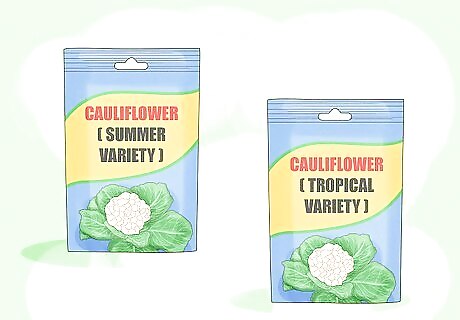
Adjust to a difficult climate. Cauliflower is one of the most temperature-sensitive vegetables around. If the temperature requirements above seem difficult to achieve in your area, you can make the job easier with one or more of these tactics: Look for "summer" or "tropical" varieties that can handle warmer temperatures than most. Wait about a month after the recommended seed-starting date and buy a transplant from a garden store. Plant a new batch every week for 4–6 weeks to see which works best.
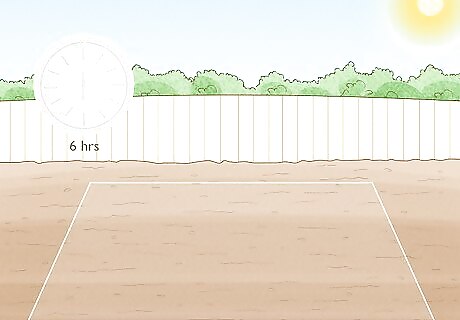
Choose a growing site with at least six hours of full sun. Though they require cool weather, paradoxically, cauliflower also require a fair amount of full sun during the day. Choose a spot for planting in your garden that receives full sun and isn't shaded by trees, tall grass, or other crops. You'll also want to make sure that your growing site has ample room for your cauliflower crop. Generally, cauliflower plants will need to be spaced about 18-24 inches apart.
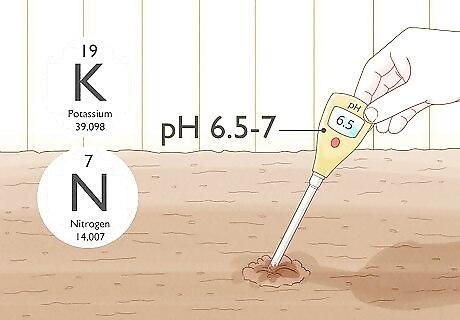
Start with rich, moisture-retaining soil. For a good cauliflower crop, the plant's growth must be completely uninterrupted. This means that the plant must receive consistent moisture and have access to sufficient nutrients as it matures. A good soil makes meeting both of these requirements much easier. Ideally, your cauliflower's soil should have the following qualities: High organic matter content. This enhances the soil's ability to hold moisture. High potassium and nitrogen content. Potassium and nitrogen are nutrients vital for the cauliflower's development. If these are not present in the soil, it may be necessary to use fertilizer. A pH of between 6.5 and 7. This "sweet" pH range minimizes the danger of a cauliflower disease called clubroot and maximizes nutrient availability.
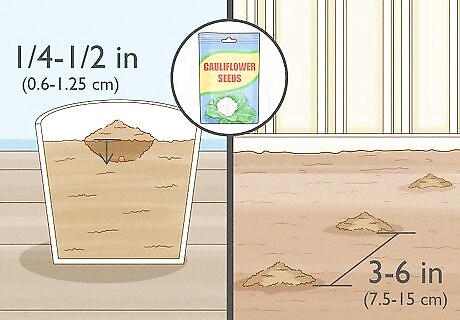
Start with transplants or grow seeds indoors. Cauliflower has a reputation for being somewhat fragile. Many people start with seedlings from a local garden store to transplant into their garden. If you have seeds instead, plant them indoors to protect the young plants from weather: Plant each seed in its own peat or paper cup. The biodegradable container lets you "plant" the whole pot in your garden later without damaging the cauliflower's roots. Press the seed about 1/4–1/2 inch (0.6–1.25 cm) deep and cover it with dirt. Water regularly so the soil is moist but not waterlogged. In cold weather, keep the soil at 70º F (21º C) with bottom heat from a warming plate. If you must plant your seeds directly in the garden, plant them in rows 3 to 6 inches (7.5 to 15 cm) apart.
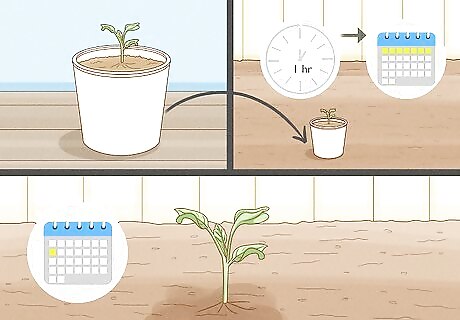
Transplant the seedling. Whether you grew the plants from seed or bought them from a garden nursery, you'll need to move them outdoors once they have three or four true leaves: Before transplanting, move the seedlings outside for one hour a day. Gradually increase this time over the course of a week to "harden off" the seedlings, adapting them to outdoor conditions. If you used a biodegradable container, bury the container in the ground so the soil level is even with the rest of the garden. If you used a non-biodegradable container, remove the seedling carefully to avoid breaking its roots. Make a small hole in the ground and bury the seedling up to its stem. You may want to make a shallow, saucer-like depression around the seedling to help the surrounding soil retain water. Firm the soil and water the seedling.
Caring for Growing Cauliflower
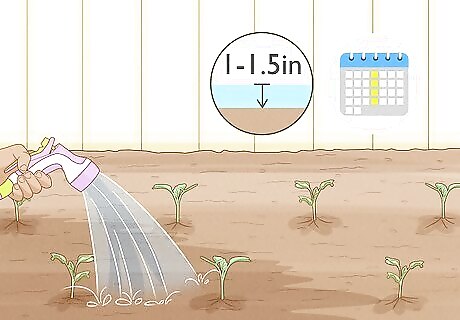
Water consistently, providing 1 - 1.5 inches (2.5 - 3.75 cm) of water per week. The most important idea when it comes to growing cauliflower is that of consistency. Cauliflower plants need consistent access to moisture and nutrients or their growth won't be consistent. If the plants' growth isn't consistent, the final product that you eat won't have as good of taste or texture. After planting your cauliflower plants, ensure that each receives frequent watering so that its soil is consistently damp (but not waterlogged). This usually means that the plants should be receiving roughly 1 - 1.5 inches of water per week and that the moisture should be penetrating roughly 6 inches (15.2 cm) deep. Note that rainfall can contribute towards this watering goal. Thus, if you experience frequent rainfall, it's possible that you may rarely need to water.
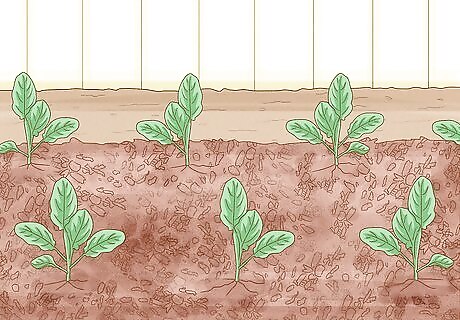
Mulch the planting area. Once the seedlings are growing in your garden, cover the soil with a light layer of mulch to help retain moisture and regulate temperature.

Be ready to protect young cauliflower from pests. When cauliflower seedlings are young and fragile, they are vulnerable to a variety of garden pests, including cabbageworm, aphids, harlequin bugs, and more. This especially true in cases where cauliflower is being planted as a spring crop, as the end of the winter months usually coincide with a surge in insect populations. Some of these pests can interfere with the cauliflower's growth cycle - others can eat the plant to ground, ruining your crop entirely, so managing these pests at the first sign of trouble is a top concern for serious gardeners. Nontoxic pest treatments include diatomaceous earth, soap sprays, and cultural practices such as controlling humidity or introducing predator insects. Look up integrated pest management practices to find out more. You can also use plant-friendly pesticides, but read the label carefully. Using the wrong pesticide or applying pesticide incorrectly could damage your plants or make the vegetable unsafe to eat. To prevent pests from reaching your cauliflower, try cutting old milk jugs in half and laying them over the seedlings for protection.
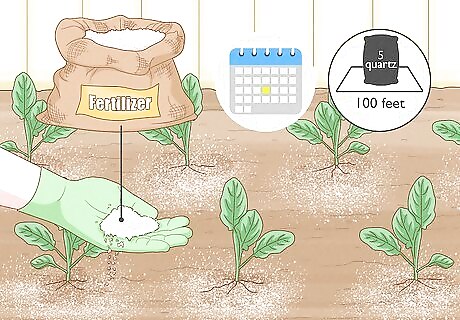
Fertilize to supplement the cauliflower's growth. If growth is slow or you suspect your soil is low quality, test your soil. If your soil is relatively low in nitrogen (N) and potassium (K), bolster these nutrients with fertilizer. Apply a fertilizer high in the missing nutrient(s) every two to three weeks. You may also apply seaweed extract to supply boron, an important nutrient. For a large home garden, you can use a mixture of 5 quarts of fertilizer for every 100 feet (30.5 m) of crop row. Use a technique called side-dressing to administer your fertilizer to the maturing plant. Dig a shallow, narrow furrow parallel to each row of plants about 6 to 8 inches away from the plants' stems. Pour the fertilizer into this furrow, rake the soil, and then water. This ensures that the fertilizer can be administered in equal, constant proportions to each plant and helps minimize the danger of over-fertilizing.

Blanch the head to prevent it from darkening. As the cauliflower grows, a small "head" will begin to form at the center of its leaves (note that this is sometimes also called the "curd"). For ordinary white cauliflower, if this head is exposed to light while it is growing, it will yellow and darken. Though a darkened head of cauliflower is still edible, it is less visually appealing and will have a less-tender texture. Thus, it's important to use a process called "blanching" to keep the head pale and white. When the head is roughly the size of an egg, bend the plant's own leaves over the head so that it is shaded from sunlight. If necessary, use twine or rubber bands to hold the leaves in place. Trapping moisture around the head can cause the plant to rot. Confirm the head is dry before blanching, and take care not to get any water on the head while it is bound. Don't bind leaves so tightly around the head that air cannot reach it. Note that non-white varieties of cauliflower (like purple, green, or orange cauliflower) do not need to be blanched. Additionally, some varieties of white cauliflower are bred to be "self-blanching", with leaves that naturally protect the head as it grows.

Harvest when heads are large, white, and firm. After blanching, continue caring for the plant as normal, occasionally removing the leaves around the head to monitor its growth and allow moisture to escape after watering. When the head is large (roughly 6 inches (15.2 cm) across), white, and firm, it is ready to be harvested. This can be anywhere from a few days to a few weeks after blanching, depending on your climate (growth is generally faster in hot weather). Cut the head from the base of the plant with a knife, leaving a few leaves attached to protect the head. Rinse, dry, remove the leaves, and enjoy. Cauliflower can be stored in a variety of ways. It will last for roughly a week in the refrigerator and can be frozen or pickled for long-term storage. Alternatively, cauliflower can also be stored by pulling the plant up by its roots and hanging it upside down in a cool place for up to a month.
Treating Common Cauliflower Ailments
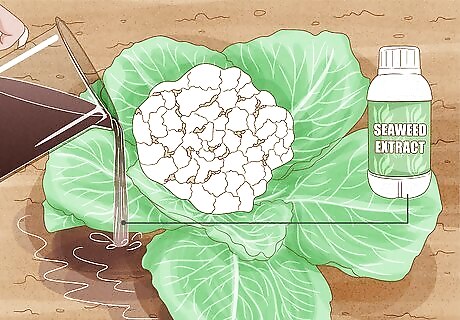
Treat boron deficiency with seaweed extract. If cauliflower doesn't have access to boron, an essential nutrient, it will begin to experience a variety of unappealing symptoms. Its head will turn brown, its leaf tips will die and its leaves will distort, and its stem may become hollow and brown. To treat this problem, boron must be introduced into the plant's soil immediately. Feed the plant with seaweed extract immediately and repeat every two weeks until symptoms disappear. For subsequent crops, add boron to the soil by mixing in compost or planting cover crops of vetch or clover.

Stop clubroot by eliminating infected plants. Clubroot is a fungal infection that causes large growths on the roots of plants in the family Brassicaceae (which includes cauliflower, broccoli, cabbage, Brussels sprouts, and other plants). These root growths interfere with the plant's ability to absorb water and nutrients, causing it to grow asymmetrically, wilt, and eventually die. Worst of all is the fact that clubroot is contagious and can easily spread from plant to plant. To prevent a case of clubroot from ruining your entire cauliflower crop, swift, aggressive action must be taken. Pull infected plants up by their roots and discard them (don't compost them). Be sure to remove the entire root system - any fungus left in the ground can release spores and continue spreading. To prevent clubroot from returning, use one of the following methods: Improve the drainage of your soil by adding organic matter (clubroot thrives in moist environments). Plant a cover crop of winter rye and till it into your soil before planting cauliflower. Rotate your crops. Do not plant brassicas or in the same area two years in a row. Increase the alkalinity of your soil by mixing in hydrated lime in the fall (clubroot thrives in acidic soils) Lay thin sheets of clear, construction-grade plastic over infected soil during sunny weather. Leave in place for 1 - 1.5 months. The plastic acts as a sort of "greenhouse", trapping the sun's rays to heat the soil and kill the fungus.
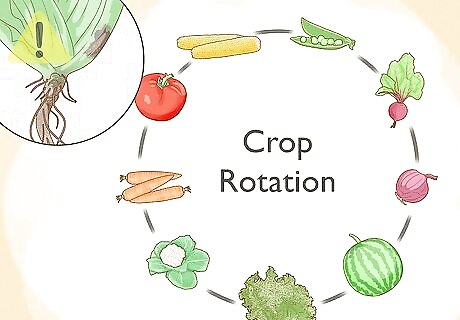
Prevent blackleg by practicing crop rotation. Another common fungal disease of cauliflower is blackleg. Blackleg causes irregular grey lesions or holes in the leaves and is sometimes accompanied by root rot. Like clubroot, this disease is difficult to treat, so preventative cures are the best bet. In particular, crop rotation is an effective technique for reducing the chance of blackleg. Don't plant cauliflower (or another member of the Brassicaceae family) in the same location more than one year in a row - this gives any remaining blackleg fungus in the growing site a year to die off. Additionally, in the event of blackleg, remove all plant debris left over after a harvest. This dead or dying plant material can contain live fungi for months, leading to the re-infection of the next crop. If you have any doubts about whether certain seeds are contaminated with the fungus or not, washing the seeds in hot water can help remove the fungus prior to planting.




















Comments
0 comment